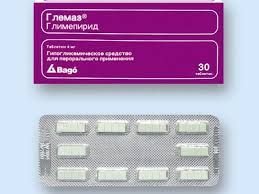
All iLive content is medically reviewed or fact checked to ensure as much factual accuracy as possible.
We have strict sourcing guidelines and only link to reputable media sites, academic research institutions and, whenever possible, medically peer reviewed studies. Note that the numbers in parentheses ([1], [2], etc.) are clickable links to these studies.
If you feel that any of our content is inaccurate, out-of-date, or otherwise questionable, please select it and press Ctrl + Enter.
Bagomet
Medical expert of the article
Last reviewed: 03.07.2025

Bagomet is the optimal drug for the treatment of type 2 diabetes, helping to avoid complications that most often lead to the death of patients and improving their quality of life. The drug normalizes blood pressure in patients with diabetes.
ATC classification
Active ingredients
Pharmachologic effect
Indications Bagomet
Diabetes mellitus type II (insulin independent), diabetes mellitus type I (insulin dependent).
Release form
Bagomet is available in the form of coated tablets.
Pharmacodynamics
Increases the body's sensitivity to insulin. Does not affect pancreatic function. Enhances blood circulation in the liver and suppresses glucose production. Stabilizes weight. After the first month of taking Bagomet, weight drops by 2% on average due to decreased appetite and carbohydrate absorption. Doctors often hear from their patients a request to prescribe Metformin for weight loss. Reduces cancer risks. Improves glucose consumption by muscles.
Pharmacokinetics
The maximum concentration of Bagomet in the blood is reached after 2 hours. It accumulates in the salivary glands and kidneys. It is excreted by the kidneys. The half-life of Bagomet is 6.5 hours.
Dosing and administration
Take 2-3 tablets per day, not exceeding a dose of 3000 mg. The starting dose of metformin is 500-850 mg during or after meals, with a gradual increase of 500-850 mg per week. The average dose is 2000-2500 mg.
When a patient switches from another drug to metformin, the previous tablets should be discontinued and metformin therapy should be started, with the exception of replacing chloropramide (a 21-day break in treatment is taken, the drug is eliminated from the body for a long time).
Concomitant use of Bagomet and insulin therapy
If the insulin dose is below 40 IU per day, the usual daily dose of the drug is 2 tablets. The insulin dose is reduced (by 2 - 4 IU), regularly monitoring glucose.
Use Bagomet during pregnancy
Bagomet is not used during pregnancy.
Diabetes is diagnosed for the first time in 5% of pregnant women.
You may be diagnosed with diabetes during pregnancy if:
- Someone in your family: parents, brother, sister, has diabetes.
- Your blood glucose levels were at the upper limit of normal before pregnancy.
- You are overweight.
- You suffer from arterial hypertension.
- You had elevated blood glucose levels during your previous pregnancy.
- Your previous child was overweight or underweight at birth.
- If you have gained more than 10 kg during pregnancy.
- You have habitual miscarriage.
The danger for a baby born to a mother with diabetes diagnosed during pregnancy is that it may be born too large and susceptible to neonatal jaundice. Pregnant women with diabetes are more likely to have bladder and kidney infections, which are working hard to keep the baby alive and detoxify the body.
The difference between the treatment of gestational diabetes and type 2 diabetes is that they are contraindicated in hypoglycemic agents. Therefore, they are prescribed insulin. The diet of gestational diabetes patients should not be aimed at weight loss!
After childbirth, diabetes may disappear. To prevent your child from developing diabetes, be sure to breastfeed. Avoid alcohol and sugary drinks after pregnancy.
Contraindications
Diabetic coma, severe renal dysfunction; heart failure, myocardial infarction, stroke, chronic alcoholism, pregnancy and breastfeeding, hepatitis of various etiologies, if you work hard physically. Do not prescribe under 15 years of age.
Side effects Bagomet
Nausea (most complaints occur in the first days of taking Bagomet), metallic taste in the mouth, abdominal pain and diarrhea (it is necessary to monitor the diet more carefully, completely eliminate fast carbohydrates, and these effects will pass), lactic acidosis, hypovitaminosis B12, megaloblastic anemia (it is necessary to interrupt treatment), hypoglycemia (requires a dose reduction), skin rash.
Lactic acidosis is a condition in which lactic acid enters the blood, resulting in increased blood acidity, and a person may die. Lactic acidosis can be caused by chronic alcoholism and infections, injuries, poor kidney function, heart and vascular diseases, blood cancer. If you are taking Bagomet and notice muscle pain combined with apathy, immediately stop the drug and contact your doctor! If you do not take action, loss of consciousness and coma occur. The doctor will put in an IV and prevent the progression of this condition.
The risk of developing lactic acidosis is less than one case per 100 thousand patients. The drug is well tolerated by patients with type 2 diabetes.
 [ 1 ]
[ 1 ]
Overdose
In case of overdose, the patient requires immediate hospitalization and hemodialysis.
Interactions with other drugs
When used simultaneously with sulfonylurea derivatives, MAO inhibitors, the hypoglycemic effect may be enhanced. When used simultaneously with oral contraceptives, glucagon, diuretics, nicotinic acid, Bagomet excretion decreases, which increases its side effects.
 [ 2 ]
[ 2 ]
Storage conditions
Keep out of reach of children, protected from light.
Shelf life
Bagomet's shelf life is 2 years.
Manufacturer
Attention!
To simplify the perception of information, this instruction for use of the drug "Bagomet" translated and presented in a special form on the basis of the official instructions for medical use of the drug. Before use read the annotation that came directly to medicines.
Description provided for informational purposes and is not a guide to self-healing. The need for this drug, the purpose of the treatment regimen, methods and dose of the drug is determined solely by the attending physician. Self-medication is dangerous for your health.

